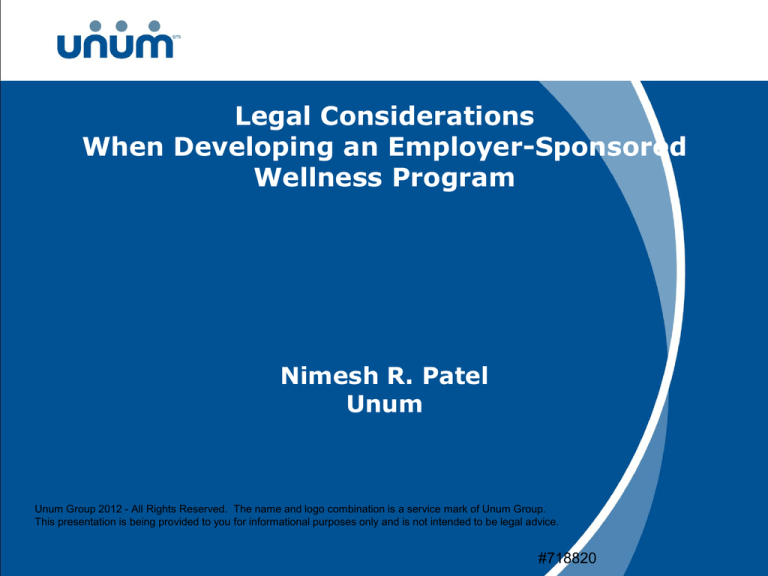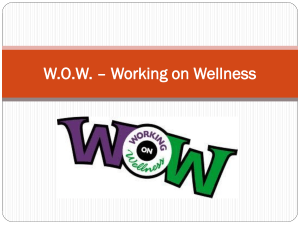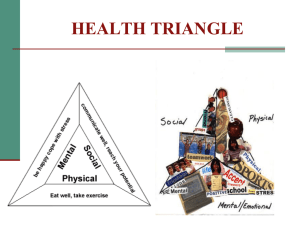
Legal Considerations
When Developing an Employer-Sponsored
Wellness Program
Nimesh R. Patel
Unum
Unum Group 2012 - All Rights Reserved. The name and logo combination is a service mark of Unum Group.
This presentation is being provided to you for informational purposes only and is not intended to be legal advice.
#718820
Session Overview – Legal Issues to Consider
•
Explore (briefly) the current landscape
Primary Focus
• ERISA
• HIPAA
•
•
– Nondiscrimination and wellness rules
– Privacy restrictions
ADA
Tax
Other Misc. Legal Considerations
• Title VII
• ADEA
• GINA
2
The Big Picture: What’s Happening to Healthcare
Costs
Basic Facts
• Healthcare spending in the U.S. accounts for 16% of GDP and costs have been rising
at more than double the rate of inflation over the past decade. (CDC)
• Premiums for employer-sponsored health insurance have been rising four times faster
on average than workers’ earnings since 2000. (Kaiser Family Foundation)
• Average employee contribution to company-provided health insurance has increased
more than 143 percent since 2000. (Hewitt Associates)
• Companies spend up to 52% more in annual healthcare costs on overweight
employees than they do on employees at a healthy weight (Journal of Occupational
Environmental Medicine)
• 75% of all medical spending is for chronic disease – up from 60% in 2000 (source:
CDC)
• 70% of all healthcare costs in the United States are attributable to preventable risks
and unhealthy choices. (CDC)
• 66% of employers are moving toward more aggressive wellness and disease
management programs. (Hewitt)
• 50% of employers offer or planned to offer incentives to increase participation in
health initiatives, up from 38 percent a year earlier. (Hewitt)
3
Wellness Programs - Generally
• What exactly is a wellness program?
• What are some of the reasons an employer may decide to sponsor
a wellness program?
–
–
–
–
–
Increase productivity
Reduce health care expenditures
Improve company image
Attract and retain talent
Increase company morale
4
Employee Perceptions & Communication
• Communication and Education leads to buy-in.
• “What’s in it for me?”
• “You’re discriminating against me”
• Penalty or Incentive? Premium differentials look like a penalty for
those who don’t receive it.
• Educating employees about the use of HRA and claims data.
• Consistency of message.
• Identify and explain the intended outcome: Lower cost trend?
Reduced risk factors? Cultural shift? Employee engagement?
• What would happen if no incentives were used or if discontinued?
Would employees continue to use the programs and services?
5
Wellness Programs
Keys to Success
•
Have a plan:
communicate
characterize population
identify risks and cost drivers
invest in programs that match needs
measure outcomes (what’s credible?)
adjust based on outcomes
•
Obtain Senior Management support
•
Incentives that are meaningful
•
Permit wellness activities in the workplace during work time
6
A Wellness Story
• Mr. Bottom-Line, the CEO of Big Profit Company, is very unhappy
with the 2012 budget. How can health care cost so much!
• Mr. Bottom-Line orders his business team to come up with a
solution. He wants to have the healthiest company around (and
make Big Profit Company even Bigger).
• The business people get busy and develop a host of cutting-edge
wellness programs. They proudly present them to Mr. Bottom-Line,
who thinks they are fabulous.
CEO
7
A Wellness Story
First Step – Identify employees who need help!
• Require employees to take a health risk assessment (HRA)
questionnaire that asks about family history, recent treatments,
and habits.
– To make sure everyone participates, make the HRA
mandatory – if the employee doesn't fill in the HRA, he
cannot enroll in the health plan.
– As a further incentive, offer a $25 cash payment for
completing the HRA on time.
• Then, ask the Plan's insurer/TPA to search its claims data and
provide a list of employees with conditions that cost a lot to
treat, such as diabetes or asthma.
8
A Wellness Story
Armed with claims data and the HRA results, the
business group comes up with 5 innovative
programs.
9
Announcing:
Big Profit Company's
New Wellness Programs!
Education
Stop Smoking Program
• Send educational
materials based on
"problem areas" in HRA
(for example, tips on
exercising and eating
healthy).
• Impose a 20% premium
surcharge on anyone
who smokes!
10
Announcing:
Big Profit Company's
New Wellness Programs!
Rewards for Good Behavior
Disease Management
• To reward those with ideal
weight, BMI, and
cholesterol.
• If identified as having
certain conditions, such
as asthma, diabetes, or
coronary artery disease,
encourage employees to
join a Disease
Management program
ASAP.
• If meet ideal, receive 30%
off on premiums.
• One-time-only offer!
• If they do, this group will
receive an additional
10% discount on
premiums as long as
they keep participating.
11
Announcing:
Big Profit Company's
New Wellness Programs!
Case Management
• For those with very serious
conditions – transplant
patients, premature infants . . .
• Sign them up for Case
Management.
• If they don't enroll, no more
benefits for the rest of the
plan year.
12
A Wellness Story
• Mr. Bottom-Line is interested in "results, results, results."
• So, the Plan will send out quarterly reports on each division's
progress (with no names, of course).
• Year-end bonuses to division heads with the healthiest teams or
most participation!
13
A Wellness Story
• As Mr. Bottom-Line and his crew are about to go to print with a
glitzy brochure with all these new programs, they decide to run it
by someone in Benefits.
• Fortunately, the Benefits Team (who is very smart) knows about
ERISA, the HIPAA nondiscrimination and privacy rules, the ADA,
and the tax laws.
14
So, what did the Benefits people
know that the Business people
didn't?
15
Questions to Ask
• Is the program an ERISA plan?
• Does the program discriminate based on health status? If so,
does it comply with HIPAA’s nondiscrimination and
wellness rules?
• Are there HIPAA privacy restrictions?
• Does the program involve a disability or require mandatory
medical exams? If so, does it meet the ADA?
• Are the rewards taxable?
16
Is the program an ERISA Plan?
•
Does your wellness program provide medical care benefits?
– If employer is involved and program provides “medical care,”
program likely an ERISA plan?
•
“Medical care” if individualized and provided by trained professionals
(e.g., coaching by nurse, counseling by therapist, biometric
screening).
•
Not “medical care” if general education and without individual
assessment (e.g., articles about health condition, weight loss class,
etc.).
•
Example: Biggest Loser Program offered by Employer. If coupled with
individualized coaching, may be an ERISA plan.
17
If an ERISA Plan . . .
• Implications of being subject to ERISA
– Plan Document
– Summary Plan Description
– Form 5500 Filing
– COBRA
– HIPAA Privacy Compliance
– Certificate of creditable coverage
– Plan Asset Issues – can only use plan assets to provide
medical benefit reward (not cash)
18
HIPAA Nondiscrimination & Wellness
Final Regulations
• Final Regulations issued December 13, 2006.
• Applies to plan years beginning on or after July 1, 2007
(January 1, 2008 for calendar year plans).
• Final rules define a wellness program as “any program
designed to promote health or prevent disease.”
19
HIPAA Nondiscrimination Rules Summary
•
GENERAL RULE - Cannot discriminate against individual in eligibility,
contributions or benefits based on health factors (e.g., charge
different premiums based on individual health status).
•
Health factors include medical conditions, claims experience, receipt
of health care, genetic information, disability, or evidence of
insurability.
•
May distinguish among similarly situated individuals, as long as
“bona-fide employment-based classification” (e.g., full-time vs. parttime, retired vs. employed, length of service, geographic location,
occupation).
•
TWO POTENTIAL EXCEPTIONS TO ABOVE GENERAL RULE:
– May discriminate in favor of those with adverse health status.
– May discriminate as part of a HIPAA-compliant wellness program.
20
HIPAA Wellness Rules:
When do rules apply?
• Only applies if program required individual to meet health
standard to obtain reward (i.e., so-called “outcome based”).
• If “participant-only” standard, outside of HIPAA rules.
Examples:
Subject to HIPAA Wellness
• Plan has lower co-pay for employees with low cholesterol.
• Plan charges surcharge on employees who smoke.
• Plan rewards premium holiday if employee meets weight loss
goal.
21
HIPAA Wellness Rules:
When do rules apply?
Outside of HIPAA Wellness
•
Plan reimburses (all or part) cost of fitness center membership.
•
Plan waives co-pay for cost of well-baby visit in order to encourage
preventive care.
•
Plan reimburses smoking cessation class, regardless of whether
employee stops smoking.
•
Plan rewards employee for attending monthly health education
seminar.
•
Diagnostic testing program that provides a reward for participation
only and is not based on outcomes.
22
HIPAA Wellness Rules:
When do rules apply?
• If program provides reward based on satisfying health
standard, then must meet five requirements:
– Amount of reward
– Reasonable standard
– Annual qualification
– Reasonable alternative
– Disclosure
23
HIPAA Wellness Rules
Requirement #1 – Amount of Reward
• Reward for all health standard-based wellness programs
cannot exceed 20%* of cost of single employee coverage.
• Cost of coverage includes employer + employee contributions.
For example, if employer contribution is $60 and employee
contribution is $40, total cost is $100. Reward limit = $20.
• Applies to the whole family (not 20% per person).
• Reward can be in many different forms.
*Amount will increase to 30% in 2014
24
HIPAA Wellness Rules
Requirement #2 – Reasonable Standard
• Must be reasonably designed to promote good health (not well
defined – “squishy standard”).
• Will be “reasonable” if –
– Reasonable chance to improve health or prevent disease;
– Not overly burdensome (i.e., only a few people likely to
accomplish);
– Not a subterfuge for discrimination based on health; and
– Not ”highly suspect” (e.g., extreme or illegal).
25
HIPAA Wellness Rules
Requirement #3 – Annual Qualification
• Must give plan participant opportunity to qualify at least once
per year.
• Precludes plan from “locking in” reward based on initial health
status.
26
HIPAA Wellness Rules
Requirement #4 – Reasonable Alternative
• Must allow “reasonable alternative” to those who can show it
is unreasonably difficult due to medical condition, or medically
inadvisable, to satisfy standard.
• May require doctor’s certification.
• Examples:
– Reasonable alternative to stop smoking requirement –
attend smoking cessation class.
– Reasonable alternative to lower BMI requirement –
exercise 20 minutes per day.
27
HIPAA Wellness Rules
Requirement #5 – Disclosure
• Plan must disclose availability of reasonable alternative
standard in plan material describing wellness program.
• Not required to determine alternative ahead of time (may
determine if individual requests).
• Regulations provide safe harbor language:
– If it is unreasonably difficult due to a medical condition for you to achieve
the standards for the reward under this program, or if it is medically
inadvisable for you to attempt to achieve the standards for the reward
under this program, call us at [insert telephone number] and we will work
with you to develop another way to qualify for the reward.
28
Other Wellness Issues –
HIPAA Privacy
• May need privacy procedures to safeguard information.
• May need to include HIPAA privacy notice.
• May need business associate agreement with wellness
program vendors.
• May need authorization to disclose PHI (for example, to
employer to pay incentive or to report results).
29
Other Wellness Issues –
ADA
•
What is the ADA?
•
ADA prohibits “medical examinations and inquiries” unless voluntary.
– What does the term “voluntary” exactly mean
•
The EEOC has indicated that an employer may request information as
part of a “voluntary” wellness program if the employer neither
requires participation nor penalizes employees who do not participate.
•
An HRA may be considered a “medical examination and inquiry.”
•
Recent EEOC Guidance
30
Other Wellness Issues –
Tax
• Cash reward is taxable (employer may have withholding
obligation).
• Gift certificates/gift cards are taxable.
• Gifts are taxable (unless below de minimus).
• Premium holidays, lower deductibles, contribution to HRA/HSA
not taxable.
31
A Wellness Story: Issues
Identifying employees for programs
• HRA generally ok, but "mandatory" HRA may
violate ADA.
• Better to offer reward (such as $25). But note
that cash reward is taxable.
• Obtaining claims data from Plan’s insurer/TPA
probably ok, too, but may raise HIPAA privacy
issues. Make sure it is used for treatment,
payment, or health care operations (not
employment).
• Make sure any individually identifiable health
information obtained is safeguarded under HIPAA
privacy procedures.
32
A Wellness Story: Issues
Education
Smoker Surcharge
• Probably ok. May not
even be an ERISA
plan.
• OK - but offering reward for
reaching health goal, so must meet
bona fide wellness program
regulations.
• No reward or health
goal, so no HIPAA
problem.
• Reward limit of 20% (when
combined with other programs
requiring health goal).
• Must offer at least once per year.
• Must offer reasonable alternative to
those who cannot medically meet
health goal (e.g., participation in
smoking cessation class).
33
A Wellness Story: Issues
Reward for Good Behavior
Disease Management
• OK - but offering reward for
reaching health goal, so must meet
bona fide wellness program
regulations.
• OK - HIPAA
nondiscrimination rules
allow plan to be more
favorable to those with
adverse health status.
• Reward limit of 20% (when
combined with other programs
requiring health goal).
• Must offer at least once per year.
• Must offer reasonable alternative
to those who cannot medically
meet health goal.
• Reward is based on
participation only (no
health goal), so do not
need to comply with bona
fide wellness program
regulations.
• Reward does not need to
be combined with other
wellness programs for
purposes of 20% limit
34
A Wellness Story: Issues
Case Management
Reporting Results
• DOL Q&A: Only those with
adverse health status eligible
for penalty, so discriminatory.
To be permissible, must meet
bona fide wellness program
regulations.
• HIPAA Privacy Issue – even
if names are removed,
information must be "deidentified" for HIPAA
purposes.
• "Penalty" cannot exceed 20%
limit (when combined with other
programs with health goal).
• Beware of employment law
issues.
• If require further health goal,
must offer reasonable
alternative.
• Risk if penalty too severe.
35
Other Wellness Issues –
Misc. Legal Considerations
• Title VII
– Religious Discrimination
– Race Discrimination
• ADEA
36
Other Wellness Issues –
Misc. Legal Considerations
• GINA
– What does GINA require?
– Effective dates
Bottom Line
Wellness Programs are great but . . . be aware of the potential
legal issues!
37
Questions?
38








